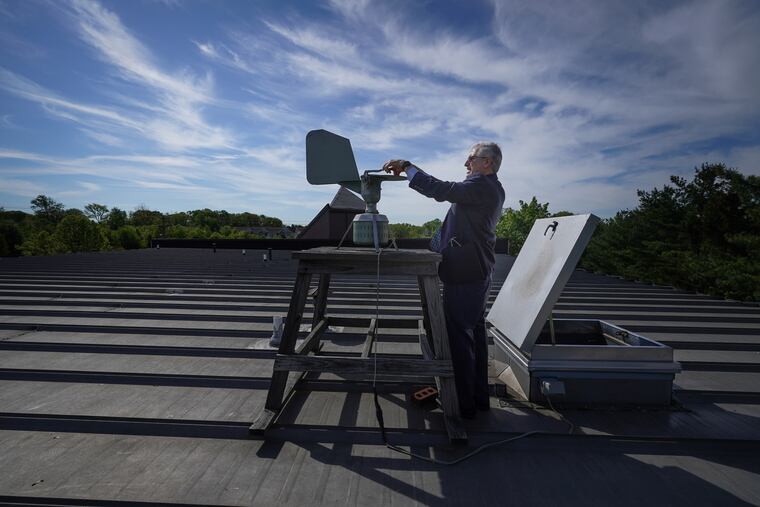The pollen season ramps up in Philly, along with the May-like temperatures
Tree-pollen counts were "extreme" Thursday morning as those bud-swollen trees are getting the jump on the pollen season.

An outbreak of spring fever would be understandable in a week when temperatures have soared well into May levels, but for thousands of allergy sufferers it may also mean outbreaks of sniffles and itchy eyes.
Those bud-swollen trees evidently are getting the jump on the pollen season, and pollen counts Thursday morning reached the “extreme” level in Philly, according to the Asthma Center, a day after they were “very high.” Pollen flight conditions should be excellent the rest of the day with highs in the mid-70s and at least until the afternoon Friday, with readings in the low 70s.
The evidence suggests that the annual equinox-to-equinox trilogy is underway, a bit ahead of schedule.
Manav N. Segal, an allergist in private practice with Chestnut Hill Allergy and Asthma Associates, said he has seen a “noticeable increase in calls” from people seeking allergy relief and expects that trend to continue. Segal said his office is gearing up for a brisk season.
» READ MORE: Sneezing seasons appear to be getting longer
“I already have patients complaining,” said the center’s Marc Goldstein. He anticipates that the high counts for cedar and cottonwood will persist the next few days.
“The unusually warm weather at the end of February gave a good kick start to the early tree pollen season,” he added.
Not to mention that temperatures are running better than 8 degrees above normal in what has been a soggy March and, this, after three months that hardly qualified as “winter,” as the trend toward milder winters and longer springs continues.
About pollen
Dispersing microscopic pollen grains is simply the way that trees, grasses, and ragweed attempt to sow the seeds for the next generation.
» READ MORE: The secret life of pollen: It can help solve crimes
However, for more than 80 million Americans, according to the Centers for Disease Control and Prevention, pollen is viewed as an invader, prompting the body to release chemicals that can set off rounds of sneezing and eye irritations.
The tree pollen season typically peaks later in April into May, when it is joined by grasses. After a break of several weeks, ragweed pollen begins to fill the air in August, continuing into September.
This is not a new phenomenon: Caesar Augustus was known to suffer seasonal allergies. However, for reasons that aren’t entirely clear, allergies spiked dramatically from 1870 until 1950 and continue to increase.
Climate factor
The pollen seasons do appear to be expanding in a warmer and moister world, according to Estelle Levitin, an aerobiologist and professor emeritus at Tulsa University.
Pollen, however, is not measured well: The counting network is sparse.
» READ MORE: The pollen-counting network in America is sparse
And predicting just how intense pollen will be on a given day is a challenge, said Levitin.
Flight conditions vary from day to day depending on temperature, winds, the amount of moisture in the air, and precipitation. Rain dampens flight, and even with higher concentrations, wetter conditions could depress counts, she said.
The weather
After another warm start Friday with highs forecast in the low 70s, showers are possible Friday afternoon.
What’s happening here is quite a contrast to what’s going on on the other side of the country. Denver is expecting maybe a foot of snow Thursday and Thursday night. We happen to be on the upper end of the seesaw.
“When it’s stormy or cold out West it’s usually just the opposite in the East,” said Dave Dombek, senior meteorologist with AccuWeather Inc.
With possible rains Friday followed by a cooldown expected into the first half of next week, pollen counts are likely to decrease.
But, unfortunately, the season is just getting started.
Advice for the suffering
Doctors advise limiting outdoor time on dry, breezy days when counts are high.
On bad pollen days, keep the windows closed if possible, and if spending time outside, it wouldn’t hurt to shower and change clothes when back inside.
To keep track of counts, the Asthma Center, which uses an automated system, posts them between 6 and 7 a.m. On Tuesday through Friday afternoons, Donald Dvorin, a certified National Allergy Bureau counter with the Asthma and Allergy Doctors, posts counts based on a 24-hour sample of what lands in his Mount Laurel trap.